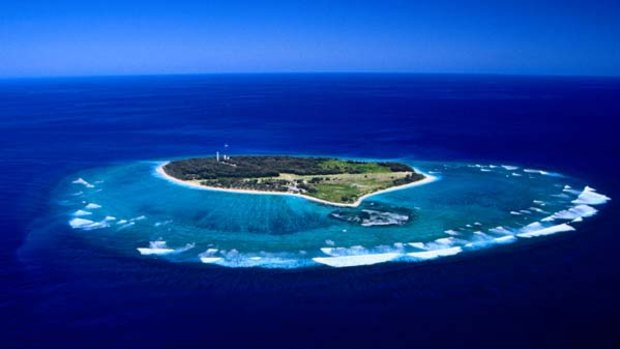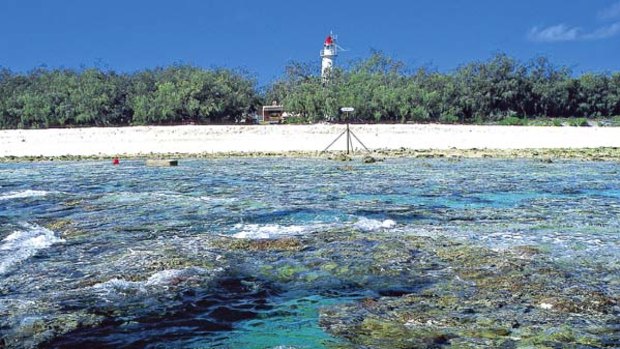
The future of eco-tourism ... Lady Elliot Island off the Queensland coast.Credit: Bob Charlton/Lonely Planet
Tom Neal Tacker mixes with manta rays and listens to whale song at an eco resort at Lady Elliot Island.
' Scissor-kick off the boat, grab the mooring line and swim towards the bottom. The manta rays should be around the first bommie on the left.'' The instructions I'm given for diving in Lady Elliot Island's waters are self-evident. I can see 30 metres under water, where the shape of a large ray is outlined against white sand.
Lady Elliot Island's location 80 kilometres off shore from Bundaberg and five kilometres from Australia's continental shelf ensures the island's waters are perennially clear and full of life. Large fish forage here as if on holiday, carefree and safe. As part of a designated green zone in the Great Barrier Reef Marine Park, the island is in the middle of a no-fishing area.

Out of the blue ... snorkellers off Lady Elliot Island.
Marine life appears to understand its protected status here. ''Let's go turtle-tickling,'' suggests a dive master, who tells me that bad dive days don't exist at Lady Elliot. ''Keep your hands away from the turtle's face - they bite - and approach it from behind so you can tickle its belly. They think we're just big cleaning fish.''
When I've dived or snorkelled with turtles at other locations, they're usually in a hurry to get away. After all, humans have hunted sea turtles for millenniums. But here, I'm no threat. Other divers have been close to these turtles before and I'm just another convenient tickler ready to comply with massage duty.
I see a few green turtles hovering above a coral outcrop and poised as if they're in underwater still-life paintings. A few cleaner wrasse fish are working on them as though they're sedans at a car wash. I swim to the back of a female turtle and gently reach underneath her right rear flipper. It's surprisingly soft to touch, almost like velvet. Her carapace is smooth. I rub her back flippers and massage her shell a bit. If I could see her head, I imagine she might look satisfied. Though turtles don't smile, I think I detect a heavy-lidded look of pleasure in her eyes.
At the next bommie, a few manta rays float effortlessly while the tide changes. I stay at the bottom, where the current is less forceful, looking up at the largest of the rays, which is easily four metres between tips. While I'm struggling against the current, the rays appear stationary, apart from a slight flexing of their massive wings. Two remoras are attached to the underside of one ray, its greyish-white skin tone blending into sunlight piercing the water. They are breathtakingly graceful.
Anyone who dives the Great Barrier Reef will know that its biodiversity is astounding in its complexity. For amateurs like me, it can be mind-boggling. Everywhere I look, I see more species of fish, more rays, more sharks, coral and invertebrates than I've ever seen anywhere else during a single dive. What Lady Elliot Island offers diving enthusiasts is unique among our unique underwater wonders. It's a list I enjoy compiling. Kaleidoscopic colours? Tick. Plenty of fish? Tick. Rare resident manta rays? Tick. Turtles that like to be tickled? Tick. Humpback whales stopping in for a visit? Yes, tick that, too.
The last surprises me. Migrating whales normally avoid island lagoons for fear of stranding. On their way to the safe waters between Fraser Island and Hervey Bay, whales stop at Lady Elliot for a snoop. I hear whale song during my dives here, an extraordinarily loud musical sound. Lucky for me.
Lucky also were three visitors the day before I arrived at the height of this year's whale-watching season. A mother and two daughters were snorkelling in Lady Elliot's sheltered leeward lagoon when two humpback whales swam within a metre of them. The following day when I asked them to recount the tale, the looks of utter blissful joy were still planted firmly on their faces. I'm so jealous I could spout saltwater.
Out of the water and back on the coral cay that is Lady Elliot, I make a circumnavigation of the island. It takes me all of two hours and I admit to dawdling and stopping to watch whales while the sun sets.
Though much of the action is underwater, Lady Elliot is also a bird-lover's paradise. I'm here during nesting time. White-capped and common noddy terns perch in casuarina and pisonia trees in flocks numbering hundreds. Three beautiful red-tailed tropicbirds are nesting outside a bungalow near the beach. Sleek wedge-tailed shearwaters return en masse to their sandy burrows at dusk. Curious brown boobies land on the canvas roof of the boat while we make our way to a prime dive spot off the lighthouse.
Pied and sooty oystercatchers work the beach like industrious traffic guards, busily turning over coral pieces in their search for tasty morsels. Eastern reef egrets, buff-banded rails and Capricorn silver eyes patrol the grounds around the small resort area, constantly looking for something appealing to eat.
At night, the noddies keep up a fairly constant racket. Certain well-rested resort workers tell me they have grown so used to the noise they don't hear it any more but I lie awake, wondering when the last bird will finally call it a night and shut up.
The island was officially discovered in 1816 when the ship Lady Elliot sailed by on its way to Sydney. The ship was wrecked on a reef off Cardwell in north Queensland on its return journey.
By 1863, the Queensland government offered a contract to mine the island's guano deposits. That marked the beginning of Lady Elliot's decline into wasteland. By 1873, a lighthouse was built to guide miners' ships to safe anchorage. The white-towered lighthouse stands today and is the signature heritage feature of the island.
In 1874, guano mining ceased as the island's vegetation had been completely removed. Goats released on the island reduced the island's surface to bleak bare ground. All the birds had left. The resort's nature centre has a few interesting photographs on display that show how the landscape looked then, barren and stripped.
After years of neglect, in 1966 a revegetation program was initiated by the lighthouse keepers. The goats were shot and, in 1969, a tourist recreation lease was granted. By 1985, the Lady Elliot Island Eco Resort was launched.
New resort proprietors have taken the enterprise to the leading edge of self-sufficiency and environmental awareness. A new solar power plant began operating two years ago and supplies the island with 70 per cent of its energy. There are plans to make the island self-sufficient within a few years. Along with the high-tech solar power plant and desalination plant that supplies all of the island's water, the intention is to employ a mixed-use wind generator and tidal-power scheme to reach 100 per cent carbon-neutral energy creation.
Such efforts should be applauded. Lady Elliot is small - about 40 hectares in total - but it represents the larger future of authentic ecotourism. And it's a great place to mix with a mantas and tickle a turtle.
Tom Neal Tacker travelled courtesy of Tourism Queensland and Lady Elliot Island Eco Resort.
FAST FACTS
Getting there
Seair has an exclusive air charter agreement to fly all Lady Elliot Island's passengers. There are daily flights to and from Bundaberg (30min) for $254 return, Hervey Bay (40min) for $254 return and the Gold Coast (1.45hr) for $599 return. Flights can be booked at www.ladyelliot.com.au. There is no ferry service to the island.
Staying there
It costs from $142 a person a night in an eco-cabin with shared facilities to $326 a person a night in a beachfront bungalow with en suites. Buffet breakfast and dinner is included as well as the use of snorkelling equipment, one glass-bottomed boat and/or guided snorkelling tour and guided island, low-tide reef walk and birdwatching (in season) tours. See www.ladyelliot.com.au.
Sign up for the Traveller Deals newsletter
Get exclusive travel deals delivered straight to your inbox. Sign up now.